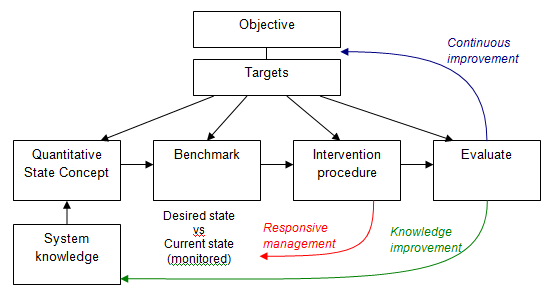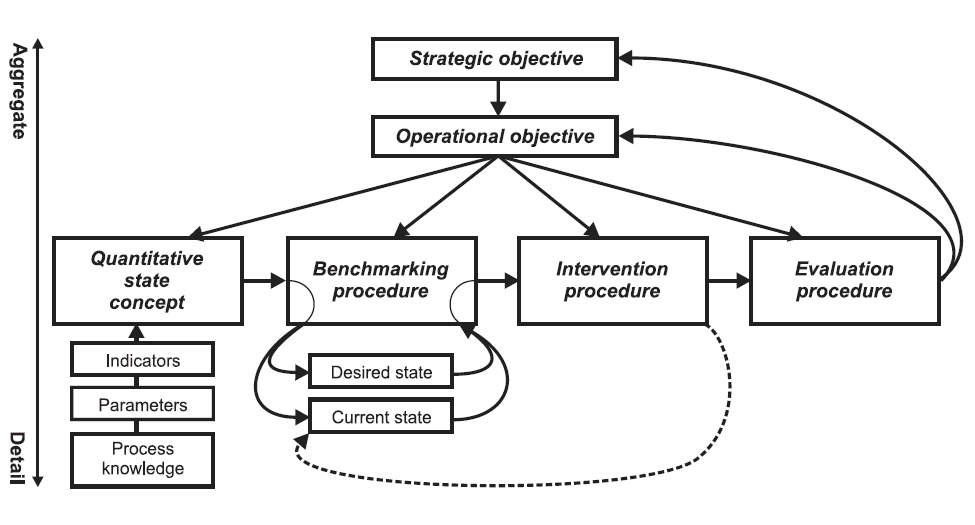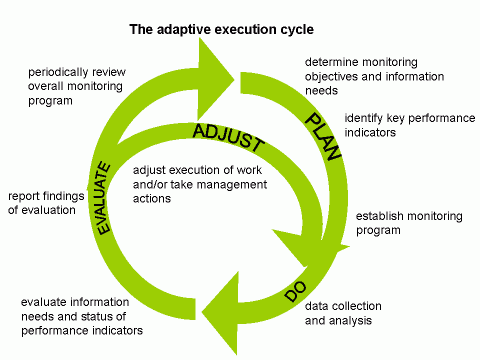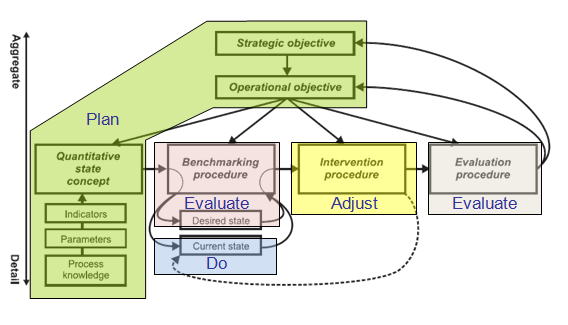In detail
Models

Adaptive management involves not only controlling your system, but also learning from your system. On the control side, which is mostly referred to as responsive management, adaptive management provides options or actions that can be used to influence impact, whereas on the learning side it provides opportunities to incorporate findings (from monitoring, field experience) into the setup of the management system. The often-used adaptive management cycle of Plan, Act, Evaluate & Adjust (Deming, 1986) is reformed in a Frame of Reference approach (Van Koningsveld, 2003) to make it more applicable to the large scale construction of marine infrastructure. A simplified setup of this approach is shown in the figure. Further information can be found in Guidelines on the application of the Framework of Reference for the adaptive execution of low-impact dredging works. This document gives the state of development at the moment of drafting (2102). However, the studies haven’t been completed yet and consequently no more clear guidelines can be provided. Development will continue and Guidelines will be updated as results become available.
One of the most important features recognized in Adaptive Management is dealing with uncertainty. Based on objectives and current knowledge levels, the parameters (Quantitative State Concept) that would be usable are identified. Trigger levels or Key Performance Indicators (KPI’s) to benchmark the environmental performance upon are also determined in the beginning of the project in the light of current (system) knowledge. In case of non-compliance responsive management (red arrow) is deployed as an intervention to influence the current state and assure monitored parameters return to values below trigger levels.
However, with the knowledge and insights gained during the works (for instance by validating models, observing patterns in the field, obtaining more reliable biological knowledge), the parameters and their trigger levels might need to be updated, or the selection approach for the responsive management practices might need changes. This process of knowledge improvement (green arrow) delivers a second cyclic activity under the adaptive framework. With this improved knowledge the benchmarks and intervention procedure may be adjusted, leading to a more effective responsive management.
Finally, as for any management systems, the adaptive management includes (management) review. Apart from the well-known feedback loop, in which the fulfilment of objectives strived for is benchmarked, a broader reviewing process is taking place, as on the basis of experience, the views on objectives and target might also be changing. It is therefore better to refer to this process as the system of continuous improvement (blue arrow).
More detail is provided further sections and in Guidelines on the application of the Framework of Reference for the adaptive execution of low-impact dredging works.
Adaptive Monitoring & Management cycles

Monitoring of the ecosystem affected by marine construction works has become an important part of any large-scale development. The use of information obtained during these extensive monitoring campaigns is varying, making the ‘success’ of using these monitoring efforts as a tool to protect the ecosystem variable. To promote sustainable development with an economic use of monitoring and management in marine infrastructure, an ‘adaptive’ approach seems very promising. By using a cyclical and adaptive process, the assessment of impacts is optimized and approved ‘on the go’ and the project can be managed by its quantified monitored impacts.
Generally, the precautionary principle forms the basis for monitoring and management requirements when ecological uncertainties arise in the (pre-) design phases. Implementing the adaptive approach for future dredging works signifies a paradigm shift away from the application of the precautionary principle.
The guideline provides methodologies to structure and help organise an adaptive cyclic approach including monitoring and assessment, ‘learning by doing’.
Plan, act, evaluate and adjust!

The basic strength of the adaptive cycle is that the execution of work can be adjusted during operation in order to reach environmental goals. Since adjustments should be based on the monitoring of effects, a complete cycle of planning, execution of monitoring and evaluation of results is necessary to facilitate adjustment. In this way the well-known management cycle of Plan, Act, Evaluate & Adjust is created (for further reading see Deming, 1986).
When this cycle is applied to the adaptive executive cycle, it follows that within the ‘plan’ phase, the monitoring objectives and information needs are determined, and that the key performance indicators are identified. Finally, a monitoring program is established that can be executed during the ‘act’ phase. Within the ‘evaluate’ phase the status of the performance indicators are compared with the desired state which will either lead to the ‘adjust’
phase within the execution of work or within a review on the overall monitoring program.

When looking at this management cycle it gives a clear indication of the cycle within an adaptive process. However, it is unclear where this cycle is ‘started’ and how the adaptive process should be designed to be successful. In addition, the different steps and needs within the planning phase to get from objective to monitoring program are not clear. For that reason, it was thought that the cycle should be re-adjusted to a framework that consists of the essential components of the complete adaptive approach including the dredging execution management process. For this, use is made of the so-called Frame of Reference (FoR) as introduced by Van Koningsveld (2003) and the figures illustrate how the Adaptive Execution cycle and the Frame of Reference correlate.
Frame of Reference (FoR)
“Gone are the days where environmental considerations were second to economic interest…”
(Bray, 2008)
These days a thorough inclusion of numerous environmental aspects has become mandatory, complicating previous ways of programming dredging projects. To tackle uncertainties related to the complexity and dynamics related to the systems in which projects take place and associated lack of clarity of (environmental) impacts and restrictions it is necessary to realise that “adjusting” to new circumstances or developments as well as introducing new and clear (environmental) objectives become part of the whole execution process. The “adjusting” also entails new roles for clients and stakeholders and possibly new stakeholders as well (local governments, communities, NGOs, entrepreneurs, etc).
The purpose of the FoR here is to better manage the integration of the conservation of sensitive ecosystems with development of cost-effective construction. Monitoring, benchmarking, evaluation, reporting and improvement are integral components of the FoR. These activities provide approaches to assess the impact, appropriateness, effectiveness, efficiency and legacy of programs and a process to promote accountability.
FoR provides guidance for assessing program performance and the state or change over time in assets, against planned immediate, intermediate and longer-term outcomes. It provides opportunities to improve program and project design and delivery and to reorient construction execution at key decision points throughout the life of the strategy or policy. FoR is designed to make changes transparent so that all parties can learn, through reflection and discussion, which interventions are most appropriate, effective and efficient. Its four components — Quality Status Concept (QSC), benchmarking, intervention and evaluation support a ‘learning by doing’ approach to adaptation.
In order to make improvements in consecutive execution cycles of the adaptive process possible, it is important that all the information gathered within previous cycles is well-defined, correctly designed and documented before being used for adjustments. For instance, within the QSC and the benchmarking, evaluation cycles will update (process) knowledge and databases in such workable way that the earlier defined decisions can be reconsidered based on the new, more complete data set.
